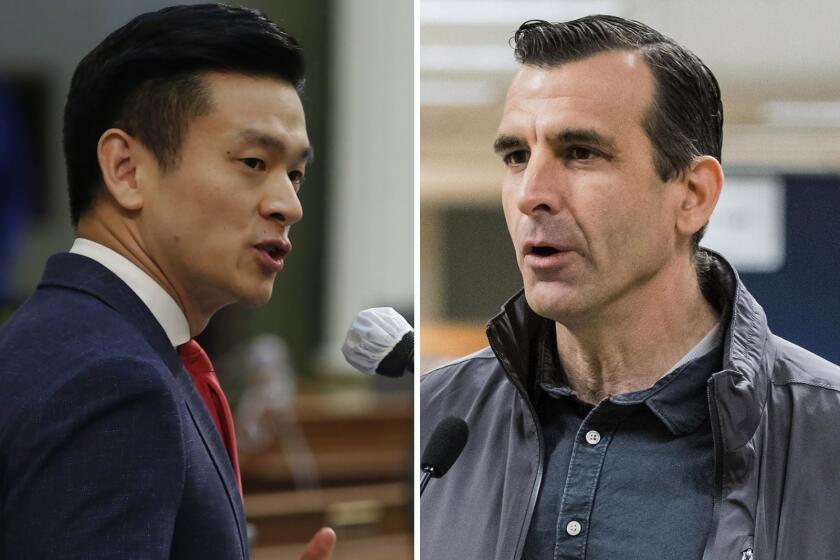Klamath Plan Will Hurt Fish, State Official Says
Officials of the California Department of Fish and Game say that endangered fish will be deprived of water they need to survive if federal officials go ahead with a plan to divert water from the headwaters of the Klamath River to drought-plagued farmers.
Under current plans, two Bush administration Cabinet officials, Interior Secretary Gale Norton and Agriculture Secretary Ann Veneman, will open head gates and release the water at a ceremony today in Klamath Falls.
Two federal agencies rushed to issue last-minute opinions Thursday that justified the release of the water, saying there was no evidence that three species of endangered fish would be harmed by the diversion of water. The opinions are required by the Endangered Species Act.
Biologists at the two agencies charged with enforcing the act, the U.S. Fish and Wildlife Service and the National Marine Fisheries Service, issued letters approving irrigation plans for the basin for the months of April and May. The approvals came a day after the announcement that Norton and Veneman would open the head gates, providing water for hundreds of farmers who can now prepare to plant their crops.
The last-minute opinion that coho salmon would not be harmed was a surprise to state officials who had been working to preserve the imperiled fish.
Agencies Hurried to Formulate Opinions
“This has been a really frustrating turnaround,” said Michael Rode, Klamath River coordinator for the California Department of Fish and Game. “Those flows are just far too low.”
Most of the Klamath River runs through California, while farmers who depend on irrigation water live in both California and Oregon.
Rode said that the months of April and May are times when both farmers and fish badly need water. Farmers need to plant their fields, while tiny coho salmon downstream in the Klamath River and its tributaries need flows high enough to allow them to seek shelter in shallow, shaded areas along streams. If the river is high enough, the newly hatched salmon--called fry--are protected by overhanging willows and can feed on insects, Rode said. One-year-old fish also need sufficient water flows in the spring to carry them toward the ocean.
The Klamath River needs at least 2,400 cubic feet of water per second during spring months to provide adequate habitat for young salmon, Rode said. He questioned how the federal officials could conclude, as they have, that salmon would not be harmed by flows of at least 1,742 cubic feet per second in early April, dropping to 1,043 cubic feet in late May--the levels laid out in federal irrigation plans for the next two months.
Rode said he will consult with other state officials about how to respond.
“You sort of get squeezed into a corner when they come out with such low numbers and so little information,” Rode said.
Jeff McCracken, a spokesman for the U.S. Bureau of Reclamation, the agency in charge of the irrigation project, said Thursday that he was not aware of the state’s concerns and that the bureau is on firm legal ground because of the opinions from the two federal wildlife agencies.
Some Federal Officials Unhappy With Plan
James H. Lecky, the National Marine Fisheries Service administrator who signed off on the diversion plan, said his agency did not have much time to review the irrigation plan.
“It’s a short period of time,” he said. “There are people on staff who aren’t happy with it. I’ll be honest about that.”
Lecky said his agency may reach a different conclusion in a separate opinion expected June 1.
Klamath Basin farmers, meanwhile, were jubilant at the prospect of water flowing Friday.
“It really shows that the Bush administration does understand that this was an unjust decision last year, and they’re going to do everything they can to make sure that this doesn’t happen to these rural communities again, with incomplete science,” said Bob Gasser of Merrill, Ore., spokesman for the Klamath Water Users’ Assn, which represents 21 irrigation districts in the basin.
The fish affected are the coho salmon in the Klamath River and the shortnose and Lost River suckers upstream of the head gates.
The basin has been beset by drought, reducing water for farmers and fish alike. Federal officials concluded last year that endangered-species laws required them to divert water from farmers for fish, causing a firestorm of controversy when some farmers filed for bankruptcy.
A committee of the National Academy of Sciences issued a much-quoted report this winter, criticizing some of the science used by the U.S. Fish and Wildlife Service and the National Marine Fisheries Service in decisions leading to that diversion.
Norton Vows to Find Solutions
This year, Bush administration officials have worked hard to avoid a repeat explosion, with Norton vowing to find a solution that satisfies all vying interests in the basin. Norton’s department oversees both the Bureau of Reclamation, which regulates irrigation in the area, and the Fish and Wildlife Service, which protects rare freshwater fish and other terrestrial wildlife.
The National Marine Fisheries Service oversees salmon and other rare ocean creatures and is part of the U.S. Department of Commerce.
The U.S. Bureau of Reclamation issued a 10-year plan for the basin in late February, but it was too late for the two wildlife agencies to review it and issue opinions before the traditional April 1 start of the irrigation system.
So in an unusual move, the bureau last Friday asked biologists at the two agencies to provide opinions by Thursday that their irrigation plans for April and May would not harm the three endangered fish. The agencies normally have up to 135 days to prepare decisions.
Suckerfish May Fall in Harm’s Way
The Fish and Wildlife Service issued its opinion Thursday afternoon, saying that the irrigation plan would not jeopardize the continued existence of the two suckerfish.
It did note that up to 100,000 larvae and 5,000 other suckers could be trapped in irrigation systems during the two-month period, but that the bureau’s installation of barriers and nets would minimize fish deaths.
The fisheries service took a different approach, saying it could not produce a biological opinion in only six days. So, the bureau issued a letter Wednesday asking the fisheries biologists to concur that planned irrigation operations in April and May would not adversely affect coho salmon.
In response, the fisheries service issued a letter late Thursday, referring to the National Academy of Sciences committee report.
“Given the conclusions expressed by the [committee],” the letter states, the fisheries service “currently has no basis for contradicting your determination, and accordingly, NMFS concurs” with the bureau that opening the head gates is not likely to hurt the salmon.
More to Read
Start your day right
Sign up for Essential California for news, features and recommendations from the L.A. Times and beyond in your inbox six days a week.
You may occasionally receive promotional content from the Los Angeles Times.






